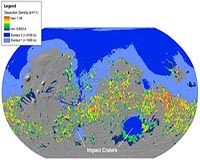 |
Moffett Field CA (SPX) Dec 11, 2009 The surface of Mars is littered with channels that appear to be the work of ancient water flows. Indeed, some of these channels meander back and forth like slow-moving streams on our planet. Channels can be carved by lava, wind and glaciers, but these processes can't explain all the features on Mars. "We've gotten over the hump and can now agree that water flowed on the martian surface in the past," says Alan Howard of the University of Virginia. But how much and when is still unclear. Howard believes the meandering channels on Mars may tell us a lot about the wet history of our planetary neighbor. Howard and a group of researchers will be tromping into the desert and the arctic to find terrestrial "meanders" that might explain their counterparts on Mars. On Earth, meandering streams occur where the floodplain is resistant to erosion. Often this is because the stream banks are held firm by grass and tree roots. "Mars almost certainly didn't have vegetation like that," Howard says. So what might have kept Martian soil in place? Howard and his colleagues have a list of possible mechanisms: clay, ice, chemical processes. They will be studying how these mechanisms create sinuous channels on Earth to see if they can pinpoint the best representation for what created similar channels on Mars. The work is funded by NASA as part of its Mars Fundamental Research program.
Martian hydrology But there are two areas on the red planet - the Eberswalde Crater delta and the Aeolis/Zephyra Plana region - where the channels snake their way through the now barren landscape. The channels were most likely carved by runoff from precipitation, Howard says. But that doesn't jive well with their age, which is estimated to be around 2 billion years old or even younger. "The width and branching character of the channels is consistent with episodes of rain or snow, but it seems difficult to have precipitation that recently," Howard says. Liquid water was thought to have disappeared from the surface of Mars more than 3 billion years ago. However, it's possible that water flowed after that - perhaps due to a large meteor impact or volcanic eruption that melted ice and created a wet micro-climate for a short period of time in the recent past. But Howard and his colleagues wonder if such a brief wet spell could create meandering rivers in the martian landscape. Are there examples on Earth that could help solve the mystery?
Making hay over clay But there are places where streams meander even though there's not much vegetation around. Howard and his group have identified several such sites in the Nevada desert. "We suspect clay sediment is providing the necessary cohesion," Howard says of these sites. In the coming months, the team will visit these desert meanders to study their geology and test whether clay is indeed able to explain the meandering. Clay has been detected on Mars in various locations, but it's mostly associated with earlier - supposedly wetter - epochs on Mars. "Clay implies a considerable amount of weathering," Howard explains. If the meandering channels on Mars formed because of clay in the soil, that would imply an appreciably wetter environment for a longer time and at a later epoch than scientists have imagined.
Other possibilities Ice in the flow of water could hinder erosion of the banks. Howard's team plans to go to Alaska, near the town of Barrow, to see if ice is playing a part in the formation of meanders there. Another possibility is chemical hardening of the stream bed. In arid environments, minerals deposited in the ground can cement together to form a hard thin layer. So-called "duricrusts" are common on Earth (and have been found on Mars), but the team has yet to find a meandering stream flowing through one. Howard says that the crusts take centuries to form, which is perhaps too long to develop the erosion boundaries needed for meandering. The situation could, of course, be different on Mars. The climate is cooler, the surface is more iron-rich, and the gravity is just 38 percent that of Earth. This last difference is something that the researchers will be looking at closely to see what effect it has on channel formation. Lastly, Howard has considered that microbial crusts - the closest that Mars could presumably have gotten to "vegetation" - may have provided soil cohesion. "It would be obviously revolutionary if organisms were responsible for the meandering on Mars, but we really have to eliminate all other possibilities first," Howard says. Share This Article With Planet Earth
Related Links - Mars News and Information at MarsDaily.com Lunar Dreams and more
 Mars valleys point to rainy red planet
Mars valleys point to rainy red planetWashington (AFP) Nov 23, 2009 A network of valleys discovered on Mars show that the red planet was likely once covered by a vast ocean that fed a humid, rainy climate, according to research published Monday. Debate has raged for decades over whether Martian valleys resulted from water erosion - caused by humidity and rainfall - or through groundwater-sapping erosion, which can happen in cold and dry conditions. ... read more |
|
| The content herein, unless otherwise known to be public domain, are Copyright 1995-2009 - SpaceDaily. AFP and UPI Wire Stories are copyright Agence France-Presse and United Press International. ESA Portal Reports are copyright European Space Agency. All NASA sourced material is public domain. Additional copyrights may apply in whole or part to other bona fide parties. Advertising does not imply endorsement,agreement or approval of any opinions, statements or information provided by SpaceDaily on any Web page published or hosted by SpaceDaily. Privacy Statement |